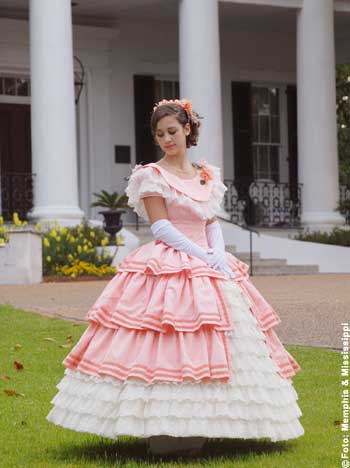Natchez – a typical Southern City

Natchez (pronounced: Notschee) was one of the first settlements and towns along the Mississippi and especially in the state of of Mississippi. According to the U.S. Census 2000 (every 10 years) the city has a population of 18.464 people.
Natchez was founded in the year 1716, more than a century earlier than Jackson.
Nearby the National Scenic Byway “Natchez Trace Parkway” starts.
Natchez is a typical Southern city and especially one that is noteworthy along the Mississippi.
Some sightseeing points in Natchez:
- House on Broadway Street,
- Longwood (140 Lower Woodville Road, also known as Nutt’s Folly, an Antebellum Octagonal Mansion),
- Stanton Hall (High Street, built in 1851),
- Natchez National Historical Park,
- Auburn (a Mansion at Duncan Park),
- Dunleith Mansion (84 Homochitto Street),
- Melrose Mansion (Melrose Ave),
- Commercial Bank and Banker’s House (206 Main St at 107 Canal St),
- House on Ellicott’s Hill (one of the first Spanish houses here, also known as Connelly’s Tavern, the James Moore House or the Gilreath’s Hill House),
- Natchez On-Top-of-the-Hill Historic District (here you’ll find several of the above mentioned mansions),
- Monmouth Plantation,
- Natchez National Cemetery.
Natchez Visitor Center
You should start your Natchez excursion here and get maps and information:
The Natchez Convention & Visitors Bureau, 640 S. Canal St., Natchez, MS 39120, Website: www.visitnatchez.org
Natchez Trace Parkway
It is, first of all, a road, 444 miles of it, stretching in a canted diagonal that leads from Natchez up to Nashville.
It is also a record, first carved out of the prehistoric wilderness by mastodons and giant bison lumbering north, and then by Native peoples, the Chickasaw, the Natchez and the Choctaw on hunting and trading parties.
Today, however, it is above all an escape route, rescuing today’s visitors from the mass-produced clutter of the modern world, as it surrounds them with unspoiled natural beauty and a rich and exciting history of our nation and our land.
The Natchez Trace Parkway isn’t the road less traveled, but it certainly feels that way with its tranquil scenic vistas. Each year more than 50,000 visitors take in the engaging exhibits at the Natchez Trace Parkways Visitors Center located in Tupelo, and yet the atmosphere on the Trace is so serene that it’s been named one of the country’s best biking roads.
The Natchez Trace Parkway often turns up on any number of “best” lists, as a National Scenic Byway that’s also been given the exclusive designation as an All-American Road for its significance in no less than six categories: archeological, cultural, historic, natural, recreational and scenic.
Approximately 800 different types of plants and more than 350 types of wildlife (including 22 federally listed as threatened or endangered species) call the Natchez Trace Parkway home, and with its camping and hiking opportunities, the Trace is also a haven for people who love the outdoors.
It isn’t only Nature that has benefited from the Trace’s wise stewardship. The Parkway’s pristine preservation includes a wealth of historical and cultural sites, like the Chickasaw Village, where exhibits relate the tribe’s history and daily life, including a nature trail of truly “native” plants and at nearby Pharr Mounds, eight magnificent burial mounds spread out over a 90-acre complex. Thanks in part to a knowledgeable and hard-working Parkway staff, the Natchez Trace experience is a perfectly adaptable, perfectly balanced adventure. For those who want to go it alone, there are ample and informative signposts, but walk-and-talks and demonstrations by Parkway Rangers also allow visitors to go deeper and get hands-on. In a program like “Myth, Magic and Medicine,” visitors can learn how native people and early pioneers used the lush foliage as their own personal medicine cabinet, with experimentation—sometimes successful, sometimes tragic—that in many ways became the “root,” so to speak, of many of today’s modern medical therapies. Living history demonstrations, like Pioneer Day, offer children and adults alike an opportunity to participate in activities such as corn shuck doll making, basket weaving, beading, leatherworking—everything from making quill pens to mountain dulcimers.
Visitor Center: A stop to go deeper
At the Visitors Center in Tupelo, the exhibits have undergone a dramatic transformation to provide greater in-depth understanding of all the many facets of the Natchez Trace while at the same time creating accessible narratives that foster and encourage personal exploration of the Trace. “Our aim was first of all to broaden the scope of the exhibits,” says Parkway Interpretive Specialist Ernie Price. “We also wanted to include more viewpoints.”
To that end, staffers engaged in a process of scholarship and outreach to Native American communities to ensure the most accurate representation.
Now organized through nine major subjects, from mound builders (the original Native Americans) to Kaintuck boatmen (who tramped the Trace on foot after selling their goods at the port in New Orleans) to military affairs (including several significant battles from more than one war) to flora and fauna to recreation, the new exhibits have so captured public interest that Price calculates the average visitor now stays four times as long at the center. Equally gratifying is the fact that visitors’ newly acquired knowledge seems to only to spark the desire to learn more. “People used to ask things like ‘how far to Jackson?’” Price notes. “Now they ask things like ‘What happened to Meriwether Lewis?’” Those questions are just the first step, Price hopes, toward more personal journeys of exploration. “We talk about two explorers, Meriwether Lewis and Hernando de Soto, in the exhibits, but we’re really hoping that visitors will also become explorers themselves.” “Don’t just stop at the pull-offs,” he advises. “Hike it, bike it, ride it on horseback. Experience every bit of it that you can.”
National Park Service (NPS) Website: www.nps.gov/natr/

